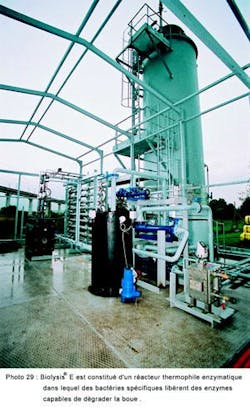Sludge reduced up to 80% at source
By Luc Delons
The Biolysis® process reduces the quantity of excess sludge produced from activated sludge plants at source by between 30% to 80% using either chemical or biological methods. Ondeo Degrémont developed the process as part of a five-year research programme, led in part by clients' needs, to lower sludge treatment and disposal costs, and to improve the environmental credentials of plant operators.
The production and subsequent disposal of sludge is a necessity for all wastewater treatment processes. All biological purification cycles lead to an increase in the biomass quantity which must be removed and treated. The treatment and disposal of sludge is a major on-going cost for all operators of water treatment facilities. Some 40 million tonnes of sludge as dry solids is produced annually from industrial and municipal water treatment plants in Europe and North America.
Two different versions of the Biolysis process are available ; one uses ozone and is based on a physico-chemical action, the other uses enzymes and is a purely biological process. Both versions are based on the principle of bacterial stress.
Biolysis O is the name given to the sludge reduction process using ozone. It involves taking mixed liquor directly from an activated sludge basin and injecting ozone into it before putting it through a contact tower. The ozonated mixed liquor is then returned back into the activated sludge basin. Ozone production is carried out in-situ in the normal way. The ozone stresses the cellular material in the biomass such that a proportion of the bacteria is destroyed and another proportion is rendered unable to reproduce.
A demonstration Biolysis O plant has been operating at the site of Aydoilles, France, for more than one year. Results obtained from the 1,000 pe (persons equivalent) activated sludge plant demonstrated no major decrease in the agricultural value of the sludge. Moreover, excess sludge resulting from an activated sludge plant, which is equipped with the Biolysis process, can be dewatered to a higher dry solids (DS) level using less polymer per tonne compared to a conventional activated sludge plant. Sludge settlement characteristics improved dramatically after the application of the Biolysis process. The incidence of filamentous bacteria observed on site at Aydoilles decreased.
Biolysis E uses a completely biological action to break down bacteria in the biomass, rendering them unable to reproduce. It consists of drawing mixed liquor from an activated sludge basin, thickening it, and then passing it through a thermophilic, enzymatic reactor operating at about 50°C - 60°C. The enzymes released by the bacteria in the reactor break down the sludge in such a way that it is unable to reproduce and grow. The heated, degraded sludge then passes through a heat exchanger to recover some of its energy before flowing back to the activated sludge basin. No external enzymatic source is used. The Japanese company Shinko Pantec originally developed this process, which can achieve up to 100% sludge reduction for some total biological sludges.
The effect of Biolysis E on sludge quality is identical to that of Biolysis O. The major advantage of the Biolysis E process is that it is purely biological, using a specific species of bacteria. This is a naturally occurring species, meaning that no bacteria needs to be imported into the system. Moreover, this species only grows actively under aerobic conditions when the temperature is 50°C - 60°C; hence the growth of conventional bacteria found in activated sludge basins at normal ambient temperatures is not inhibited at any time.
A global economic evaluation based on French prices was carried out assuming a green field site where two conventional activated sludge plants, one with Biolysis and one without, could be built. The evaluation showed that the Biolysis process in both forms does not increase the total cost of wastewater treatment.
Author's note
Luc Delons is the marketing product manager at Ondeo-Degrémont, based in Rueil-Malmaison, France.


